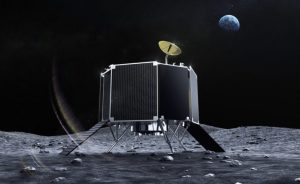
The new design of the lander sees an increase in size and payload design capacity. Standing at approximately 9 ft tall and 14 ft wide (approx. 2.7 m tall by 4.2 m wide), including its legs, it will have the capacity to deliver 500kg to the lunar surface.
Series 1, which the company is currently developing, will be for its first and second lunar missions.
The new design was unveiled at the 36th Space Symposium, currently underway at The Broadmoor Hotel in Colorado Springs.
The company says it is planned to be designed and manufactured in the United States, in partnership with General Atomics Electromagnetic Systems Group (GA-EMS) and Draper.
PDR
In June, the lander passed a preliminary design review, and iSpace is targeting a launch date in the first half of 2024
The company writes:
It has a modular payload design with multiple payload bays, allowing for flexibility and optimization for a wider range of government, commercial and scientific customers. Notably, the lander aims to be one of the first commercial lunar landers capable of surviving the lunar night and is designed to have the ability to land on either the near side or far side of the Moon, including polar regions.
Additionally, the lander’s Guidance, Navigation and Control (GNC) includes precision landing technologies capable of ensuring extraordinary accuracy during descent, including surface relative velocimetry and hazard avoidance enabling high-precision obstacle avoidance and pinpoint landing site targeting.
Its propulsion system will use five pressure-fed main engines and 12 reaction control thrusters.
It will also equipped with an engine-out capability to ensure payload delivery even in the event of an engine loss.
“As we look to the near future, Series 2 will enable us to not only increase our capabilities, but also to provide greater access and opportunities for our customers,” said Takeshi Hakamada, Founder & CEO, ispace. “Series 2 is a positive step toward realizing a diverse and sustainable cislunar ecosystem.”
Ball-shaped robot
While the robot technology is being jointly developed – by JAXA, Tomy Company (a toy company), Sony and Doshisha University – the transportation of the robot to the Moon will be conducted by ispace.
Image: ispace – Series 2 lunar lander